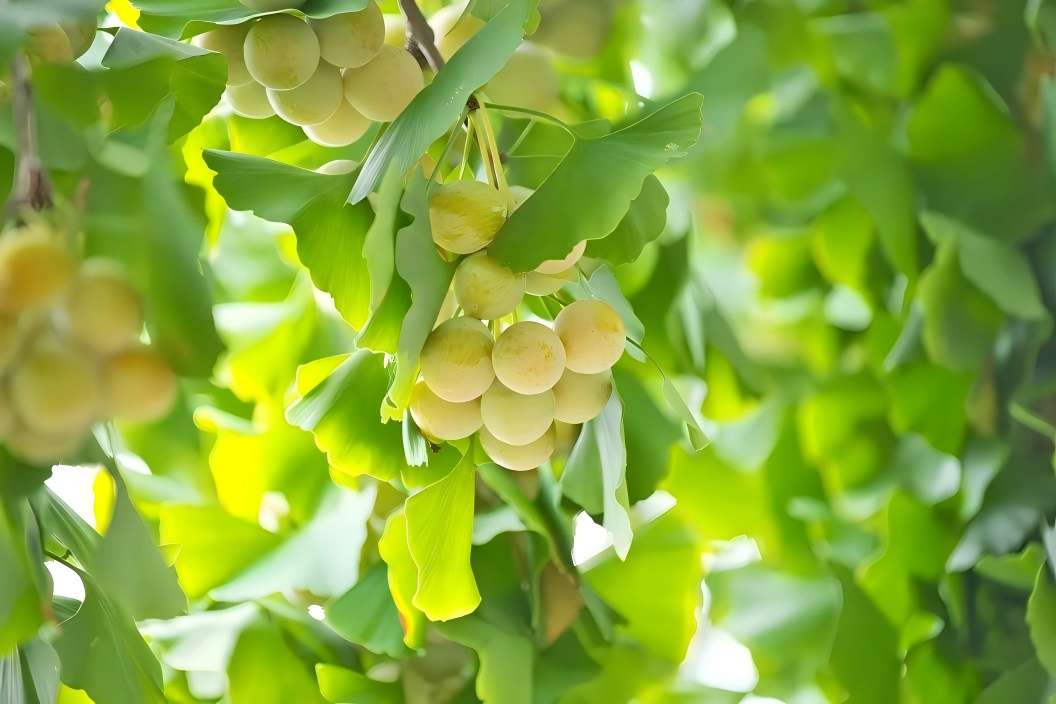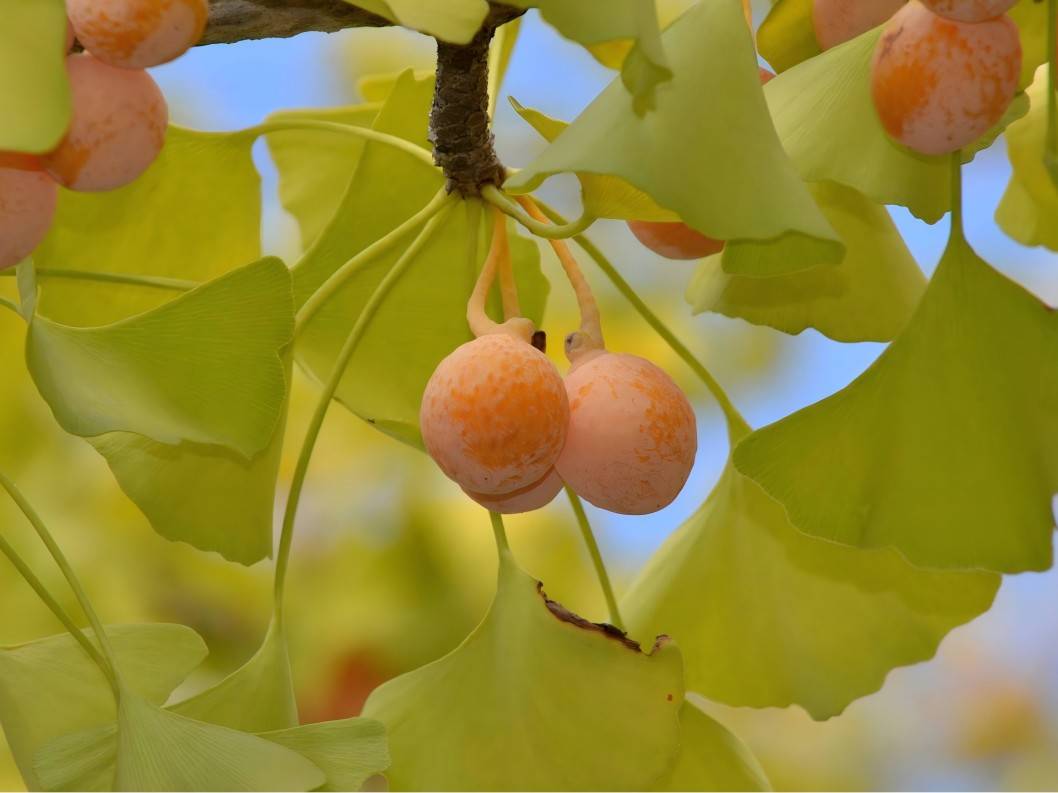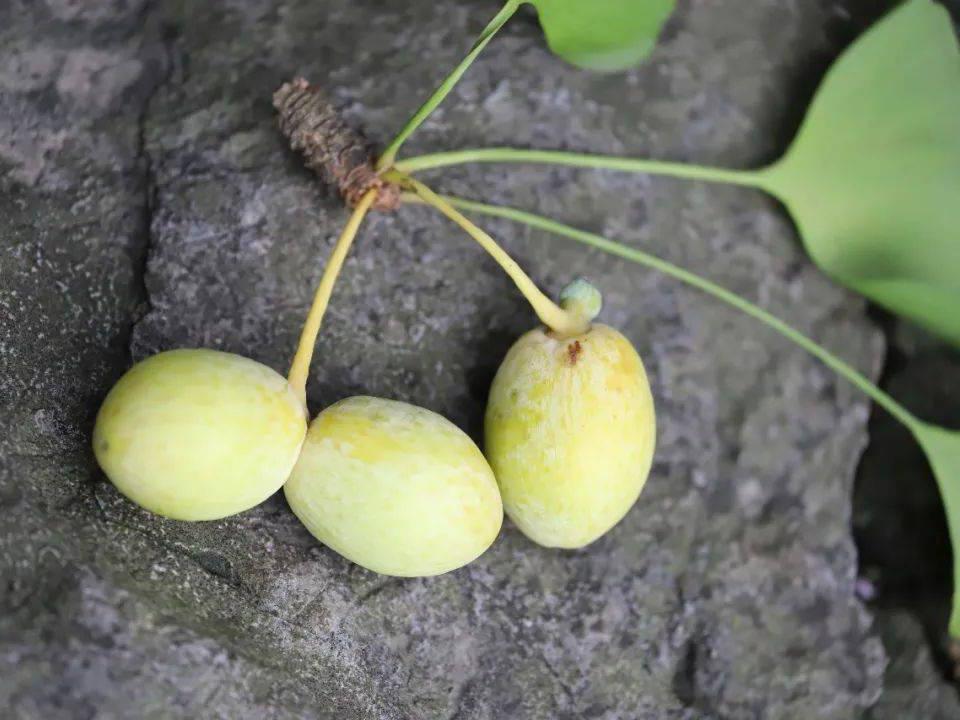What Is the Medicine and Nutrition Fact of Ginkgo Biloba Leaf?
China has abundant ginkgo resources, accounting for about 75% of the world's total. In addition, only a few pure wild ginkgoes remain in the world, such as those in Tianmu Mountain, Shennongjia and Dabie Mountain in China [1]. Ginkgo leaves are neutral in nature and have a sweet and bitter taste. They can activate blood stasis, unblock meridians, gather lung qi, relieve asthma and cough, stop vaginal discharge and turbid leucorrhoea, and lower blood lipids [2]. In recent years, ginkgo biloba leaves have been favored in many fields such as pharmaceuticals, food and health care, new ingredients for beverages and cosmetics [3].
1 The main components of ginkgo biloba leaves
Flavonoids and ginkgolides are important components of ginkgo biloba leaves that exert unique pharmacological effects.
1.1 Flavonoids
Flavonoids are the main active ingredients in ginkgo biloba leaves. The aglycones of ginkgo flavonoids include quercetin, kaempferol, isorhamnetin, etc., which are mainly found in fresh ginkgo leaves. Ginkgo biloba flavonoids can be divided into ginkgetin, ginkgetin, ginkgolides, isoginkgolides, ginkgolic acid, and 5'-methoxyginkgolic acid, which are mainly found in fresh ginkgo leaves. In addition, a total of 6 ginkgo catechin compounds have been discovered [4].
1.2 Ginkgo terpene lactones
At present, a variety of terpene lactones have been isolated from ginkgo leaves, such as ginkgolide and ginkgolides A, B, C, J, and M. Among them, ginkgolide is the only sesquiterpene lactone compound in ginkgo leaves, while the rest are all diterpene lactone compounds [5].
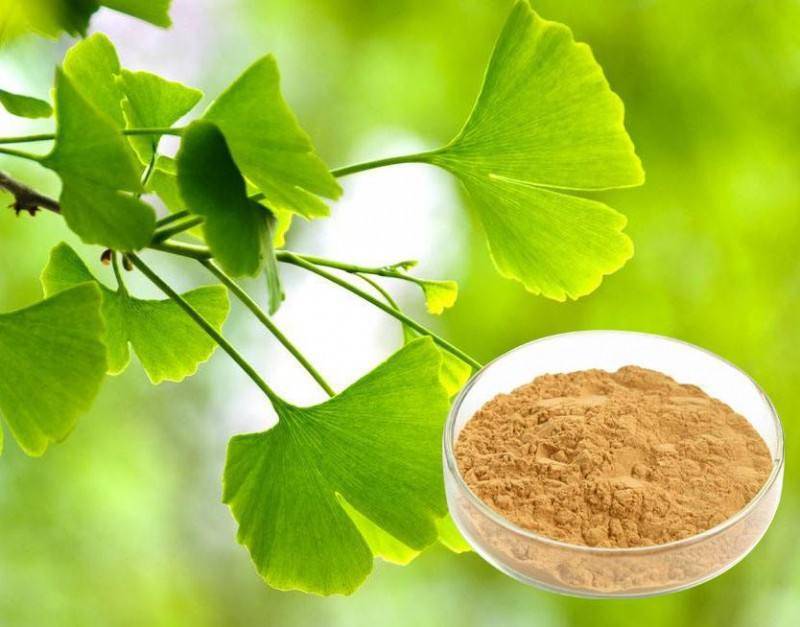
1. 3 Other ingredients
Ginkgo biloba also contains polysaccharide compounds such as water-soluble neutral polysaccharides and acidic polysaccharides. In addition, polypenol esters, alkylphenolic acid compounds, steroidal compounds and organic acid compounds are also present in small quantities in ginkgo biloba [3]. Ginkgo biloba also contains protein, vitamin C, vitamin E, carotene, potassium, calcium, magnesium, phosphorus, selenium, sugar, fat, crude fiber, etc.
2 Medicinal effects of ginkgo biloba leaves
2.1 Scavenging free radicals and acting as an antioxidant
The flavonoids and ginkgolides A, B, C and M in Ginkgo biloba extract are extremely strong free radical scavengers. Feng Jing et al. [6] quantitatively analyzed the free radical scavenging ability of Ginkgo biloba flavonoids, and the results showed that flavonoids are extremely effective free radical scavengers, which may be related to the hydroxyl group on the benzene ring of flavonoids being able to provide electrons and undergo redox reactions. Many studies have shown that ginkgolides, similar to flavonoids, have the effect of scavenging free radicals and resisting oxidative stress. They can enhance the ability to resist free radicals by increasing the activity of related enzymes in cell tissue and protect the function of mitochondria. Ginkgo biloba extract can protect cell tissue from free radical attack, making it widely used in clinical practice, especially in aging and aging-related diseases.
2. 2 Inhibits platelet activating factor
The active ingredients in ginkgo biloba can effectively inhibit platelet activating factor and are used as drugs to activate blood circulation and remove blood stasis. Ren Jiawei et al. [7] used an antiplatelet aggregation assay to investigate the inhibitory effect of ginkgolides on platelet aggregation induced by platelet-activating factor in rabbits. The results showed that there was a dose-response relationship between ginkgolides and antiplatelet aggregation, and that ginkgolides A and B had a synergistic effect. Zhang Hongmei [8] also showed in her experiments that ginkgolide B in ginkgo biloba extract has an inhibitory effect on platelet-activating factor. Ginkgolide B has a competitive inhibitory effect on the platelet activating factor receptor on the platelet cell membrane, which can antagonize the abnormal aggregation of platelets and the formation of blood clots caused by platelet activating factor. It can significantly reduce serum cholesterol and triglyceride levels, thereby effectively reducing blood viscosity and the incidence of coronary heart disease and other thrombotic diseases.
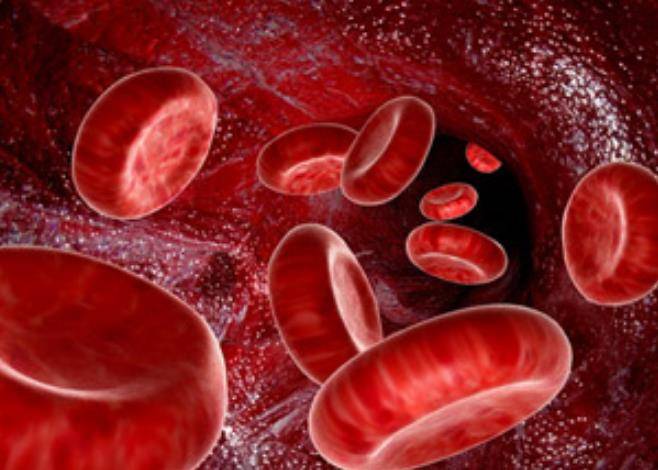
2. 3 Vasodilator and hypolipidemic
Ginkgo biloba extract relaxes blood vessels by increasing the calcium ion concentration in vascular endothelial cells, increasing the activity of nitric oxide synthase, promoting the production and release of nitric oxide, and thereby increasing the level of cyclic guanosine monophosphate [9]. The clinical efficacy of combining ginkgo biloba preparations with antihypertensive drugs is significant, especially in elderly patients with primary hypertension. Shuxiening injection is a sterile aqueous solution of ginkgo biloba extract. In patients with hypertensive cerebral hemorrhage, Shuxiening injection, in combination with conventional Western medicine treatment, can increase serum nitric oxide levels, significantly improve blood pressure, and has a stable hypotensive effect with few adverse reactions and significant clinical efficacy [10]. Wen Xiao et al. [11] used an animal model of obese mice to investigate the efficacy of Lactobacillus casei and Ginkgo biloba extract in lowering blood lipids. The results showed that Lactobacillus and Ginkgo biloba extract, when used in combination, can lower blood lipids and promote cholesterol metabolism.
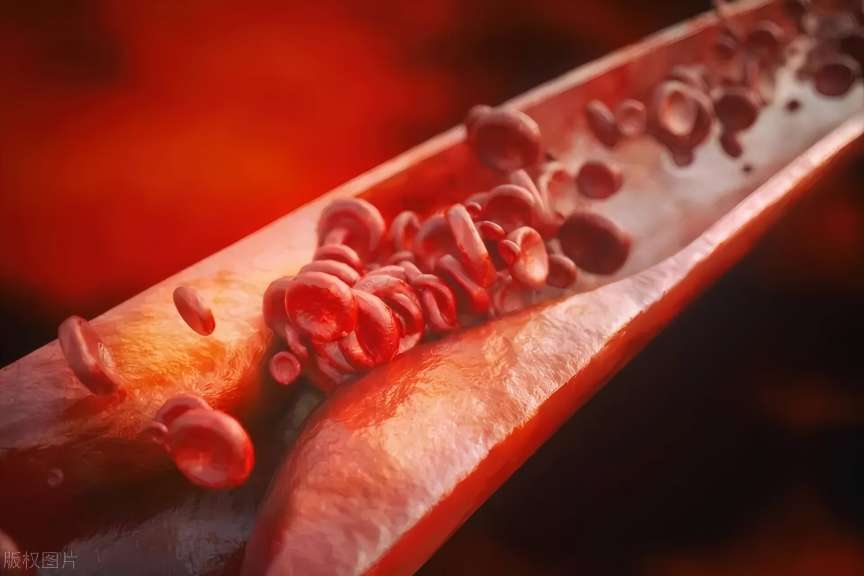
2. 4 Protecting nerve cells
Ginkgo biloba extract enhances the vitality of nerve cells, while reducing the release of lactate dehydrogenase, alleviating changes in cell nucleus morphology and DNA fragmentation, and inhibiting nerve cell apoptosis. Tests have shown that ginkgo biloba extract can increase M-choline receptors in the hippocampus, inhibit mitochondrial oxidative stress, and improve memory function, making it suitable for the treatment of Alzheimer's disease [12]. 1-Methyl-4-phenylpyridinium, also known as a dopaminergic neurotoxin, is often used to prepare animal models of Parkinson's disease. Studies have shown that isoginkgetin can reduce intracellular levels of reactive oxygen species, maintain mitochondrial membrane potential, and significantly protect against cell damage induced by 1-methyl-4-phenylpyridinium. In addition, ginkgo biloba flavonoids have the property of chelating iron ions, which can significantly inhibit the increase in intracellular iron ion levels. They are expected to become therapeutic drugs for diseases related to iron metabolism disorders, and also provide new ideas for the treatment of schizophrenia, depression, insomnia and other diseases [9, 13].
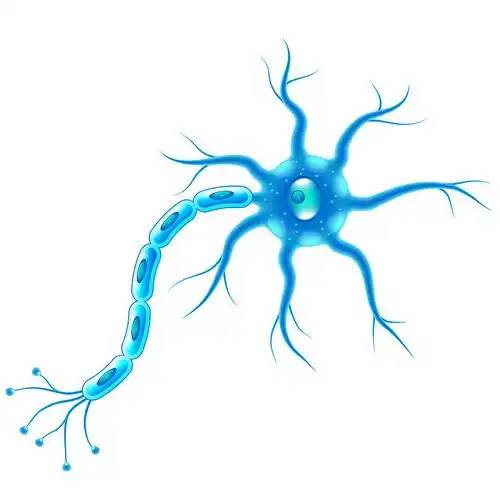
2. 5 Improve microcirculation
The flavonoids in ginkgo biloba extract have the effect of dilating and constricting blood vessels and reducing blood viscosity [14]. Experiments have shown that after treatment with ginkgo biloba extract, there is a significant increase in the number of patients with normal arrangement of blood vessels, degree of variation, blood vessel tone, rate of variation, blood flow velocity and subpapillary venous plexus, indicating that ginkgo biloba extract can significantly improve microcirculatory disorders in diabetic patients. Liu Ruixia et al. [15] found that after diabetic patients were treated with ginkgo biloba extract, all indicators of blood rheology and microvascular circulation improved significantly, which played a role in preventing and reducing diabetic complications. Ginkgo biloba extract also has a good effect in improving the microcirculation of the eyes and ears. Studies have shown that ginkgo biloba extract has a protective effect on hearing in rats, and significantly improves tinnitus and deafness caused by ischemia and metabolic disorders. In addition, ginkgo biloba preparations can directly act on the retina through the blood-ocular barrier, increase retinal blood flow, and dilate the blood vessels in the fundus, thereby repairing and protecting the retina [16].
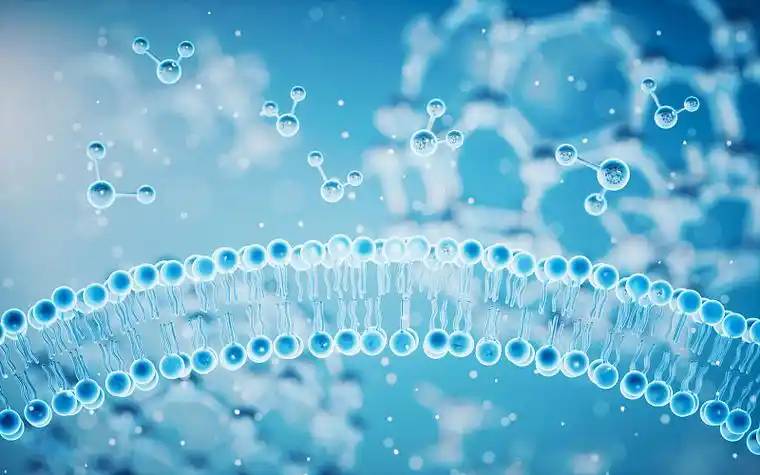
2. 6 Improves glucose tolerance and lowers blood sugar
Basic and clinical studies have shown that ginkgolide and ginkgo biloba polysaccharide have a certain regulatory effect on blood sugar. Insulin resistance and insufficient insulin secretion are the main pathogenesis of diabetes. Ginkgo biloba polysaccharide has a bidirectional regulatory effect on insulin secretion. On the one hand, it can improve hyperinsulinemia in patients with insulin resistance, and on the other hand, it can improve insulin secretion in patients with hypoinsulinemia. Yu Leiyen et al. [18] showed that ginkgo biloba and spirulina polysaccharides have a synergistic effect, which can reduce blood glucose levels in diabetic model mice, improve the body's tolerance to glucose, improve abnormal glucose metabolism, and increase the utilization of liver glycogen.
2. 7 Antibacterial and antiviral
The polysaccharides in ginkgo biloba leaf extract have a bacteriostatic effect, mainly by changing cell membrane permeability, nucleic acid formation, inhibiting protein synthesis, interfering with cell wall formation, and energy metabolism. The flavonoids in ginkgo biloba leaf extract also have a good bacteriostatic effect, which can denature fungal proteins and destroy the integrity of cell membranes, thereby causing microbial dysfunction [19]. In addition, ginkgolides have an inhibitory effect on a variety of bacteria and fungi.
2. 8 Anti-inflammatory and anti-cancer
Ginkgo biloba preparations have a significant inhibitory effect on the expression of inflammatory factors and tumor necrosis factors, and can exert anti-inflammatory and anti-tumor effects [14]. Ginkgo biloba extract can exert an anti-cancer effect by inducing apoptosis, regulating the cell cycle and gene expression [20]. Ahmed et al. [21] studied the inhibitory effect of ginkgo biloba extract on rat liver cancer and found that ginkgo biloba extract can alleviate further carcinogenesis of liver tissue and reduce alpha-fetoprotein and carcinoembryonic antigen, suggesting that the anti-cancer effect of ginkgo biloba extract is related to its anti-proliferative and apoptosis-inducing effects. Ginkgo biloba extract not only has a significant inhibitory effect on tumor proliferation, but also enhances the sensitivity of chemotherapeutic drugs [22]. Studies have shown that the flavonoids in ginkgo biloba can prevent the occurrence of tumors by improving immunity, resisting physical and chemical carcinogens and biological carcinogens, and through antioxidant and free radical scavenging effects [23].
3 Applications of ginkgo biloba
3.1 Ginkgo biloba foods
Ginkgo biloba foods mainly include bread, noodles, biscuits, etc. made with ginkgo biloba flour. The main production process of ginkgo biloba flour is as follows: high-quality fresh ginkgo biloba leaves → 3% to 5% salt water soaking for sterilization → repeated washing → impurity removal and dehydration → cutting into strips → 3% vitamin C solution immersion for 10 minutes → drying and powdering → sieving → mixing with wheat flour [24]. Ginkgo leaf noodles are made using the noodle-making process on this basis, and the final product has a chewy texture and a unique flavor. Studies have found that when making ginkgo leaf health bread, the quality of the bread is hardly affected when the proportion of ginkgo leaf powder is less than 0.5%, and the appearance, color, and texture of the bread are optimal when the proportion is 4%. The optimal recipe for Ginkgo biloba shortbread is 100 g of low-gluten flour, 32 g of icing sugar, 29 g of shortening, 17 g of egg, 10 g of treacle, and 6 g of Ginkgo biloba powder [25]. Ginkgo biloba food not only has a unique flavor, but also has a therapeutic effect on middle-aged and elderly people, lowering blood pressure and blood lipids, and improving atherosclerosis and blood circulation.

3. 2 Ginkgo biloba drinks
3. 2. 1 Ginkgo biloba compound drinks
In recent years, the processing technology of ginkgo biloba compound drinks has been constantly innovated. Geng Zhonghua et al. [26] mixed ginkgo biloba extract with crab mushroom extract in a 2:1 ratio, and added 8% sugar and 0.1% citric acid to develop a compound health drink with the unique fresh fragrance of ginkgo biloba and crab mushroom, and a delicious sweet and sour taste. Yang Zhendong et al. [27] mixed honeysuckle juice, ginkgo biloba juice, white sugar, a complex stabilizer, purified water, etc., and then homogenized and degassed, bottled and sterilized to obtain the finished product. The honeysuckle and ginkgo biloba compound beverage is nutrient-rich and has a unique flavor. It has health-promoting functions such as improving microcirculation and anti-aging. Xing Ying et al. [28] made a ginkgo health drink from ginkgo leaves and gynostemma, and the optimal formula is 5% ginkgo leaf extract and 25% gynostemma extract. It has the effect of lowering the “three highs” (high blood pressure, high blood sugar, and high blood lipids), and is especially suitable for the middle-aged and elderly to drink.
3. 2. 2 Ginkgo health tea
There are many types of ginkgo biloba health tea, which are mainly divided into green tea, black tea, oolong tea, jasmine tea and bagged tea types. Green tea-type ginkgo biloba tea is widely used because of its advantages of high yield, low labor and low production cost. The process is picking and shredding → killing and greening and kneading → drying and blending → sorting and packaging. The taste and color of the finished product are similar to those of green tea. If the greening technique is not good, it may have a certain grassy flavor [29]. Jasmine-flavored ginkgo leaf tea is made by adding jasmine flowers and aging the tea, which reduces the fishy smell of ginkgo leaf tea and adds the fragrance of jasmine, making it taste even better [3]. Yang Xiaoming et al. [30] showed that when brewing ginkgo leaf health tea, ginkgoic acid, being a fat-soluble substance, does not dissolve in the tea broth, which improves the safety of drinking ginkgo leaf tea and greatly enhances consumer acceptance.
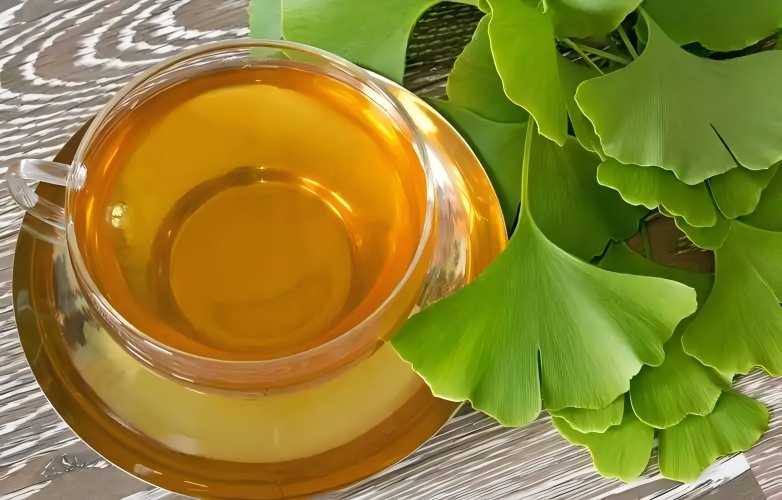
3.2.3 Ginkgo biloba wine
Traditional solid-state white wine is brewed using a portion of rice husks, which are replaced by an appropriate amount of ginkgo biloba leaves. Using modern distillation technology, a ginkgo biloba-flavored wine with a pleasant fragrance, mellow sweetness and refreshing taste can be produced [31]. Ginkgo Biloba and Jujube Health Wine: A health wine made with red dates, sugar and alcohol, and ginkgo biloba extract. It has the effect of nourishing yin and blood, and strengthening the spleen and stomach. In addition to ginkgo biloba white wine, ginkgo biloba is also used in beer. It contains ginkgo biloba and propolis, and drinking it every day has the effect of nourishing the skin and strengthening the body.
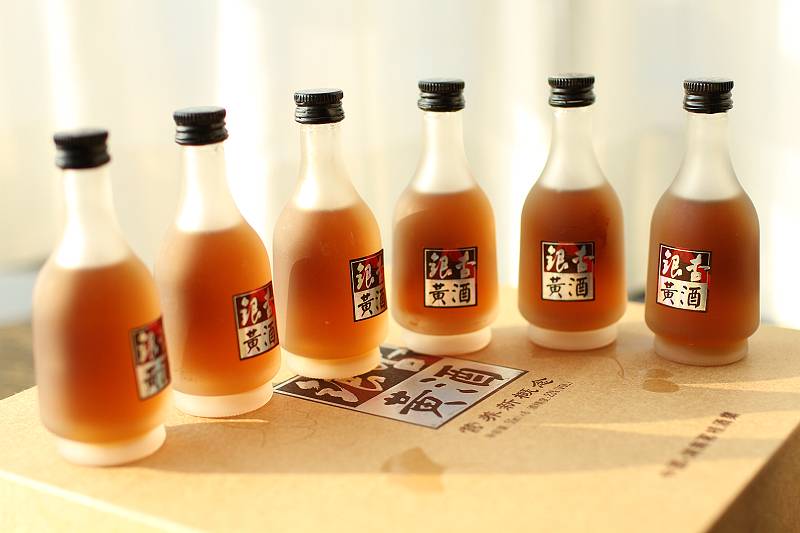
3. 2. 4 Ginkgo biloba yogurt
Ginkgo biloba yogurt is made mainly from ginkgo biloba extract and yogurt, supplemented with white sugar and stabilizers. 20% yogurt, 12% white sugar, and 2. 5 kg/T ginkgo biloba leaves are a good match. Chen Jinzhao et al. [32] innovatively developed a Ganoderma lucidum and Ginkgo biloba yogurt with nourishing and health-promoting effects suitable for middle-aged and elderly people. The best process uses skimmed milk powder as the main raw material, with 12% skimmed milk emulsion, 10% Ganoderma lucidum extract, 9% Ginkgo biloba juice, sugar 6%, etc., fermented at 42°C for 4h. Ginkgo-leaf-related lactic acid drink can not only improve the taste of dairy products, but also regulate intestinal homeostasis. In addition, the free radical scavenging ingredients contained in dairy products may be effective in anti-aging and preventing atherosclerosis and Alzheimer's disease.
3. 3 Ginkgo-leaf cosmetics
Peroxides and free radicals on the surface of the body are the main causes of skin aging and the formation of age spots. Ginkgo biloba extract has the effect of scavenging free radicals, resisting lipid peroxidation, preventing the loss of collagen, and has the effect of sterilization and anti-inflammatory, anti-viral [33]. Ginkgo biloba-related cosmetics are popular with beauty lovers, and related products cover a wide range of fields such as beauty and skin care, hair growth and protection, and weight loss. The types are even more diverse, including facial cleansers, skin creams, facial masks, shampoo, hair conditioner, toothpaste, etc.[34]. The amount of ginkgo biloba extract added to general cosmetics is 0.01% to 5%, and some vitamins E and propylene glycol are also added to promote skin absorption.
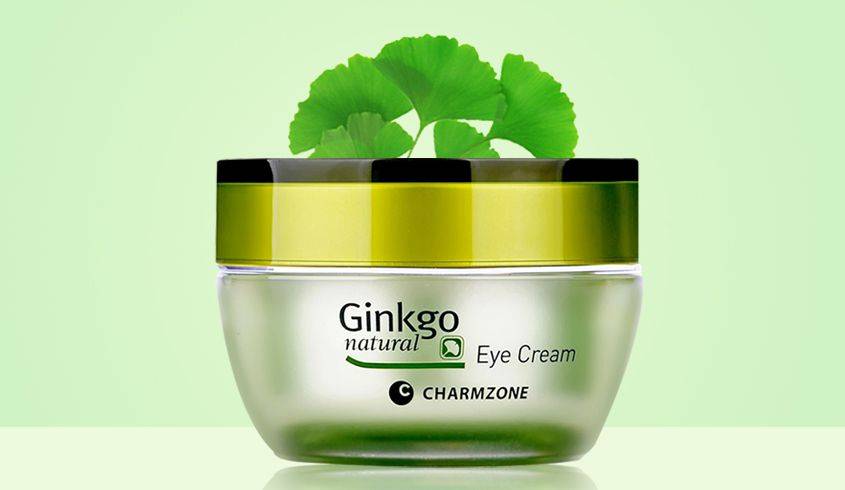
4 Prospects for the application of ginkgo biloba
China is rich in ginkgo biloba resources. As research on the various bioactive ingredients in ginkgo biloba continues to deepen, its medicinal and health-promoting value is being continuously discovered. Ginkgo biloba-related foods, health wines, health teas, cosmetics, etc. have gradually become hotspots for development and research. When ginkgo biloba is used as a raw material for food processing, how to reduce the content of ginkgolides has become a difficult problem and a direction for further research.
References
[1] Haobishalatu. The relationship between the extraction of flavonoid compounds from ginkgo leaves in Inner Mongolia and the harvest season [J]. Chinese Journal of Ethnic Medicine, 2019, 25 (9): 41-42.
[2] Cui Xulan, Chen Jintao, He Dupeng, et al. The effect of different extraction methods on the content of ginkgo biloba polysaccharides [J]. Journal of Guangzhou University of Traditional Chinese Medicine, 2019, 36 (1) : 115-118.
[3] Tang Jianqiang. Research on the development of functional products of the medicinal plant Ginkgo biloba [J]. Economic Research Guide, 2018(30) :43-44.
[4] Yang Yinfeng. Research on the neuroprotective mechanism of ginkgo biloba active ingredients [D]. Dalian: Dalian University of Technology, 2019.
[5] Ding Dong, Zhang Zhanpeng, Quan Meiping. Research progress on the chemical composition, biological activity and application of ginkgo biloba extract [J]. Jiangsu Condiment and Non-staple Food, 2015 (3): 5-8.
[6] Feng Jing, Peng Xiaoming, Li Cuiqing, et al. Antioxidant properties and stability of ginkgo biloba flavonoids. Food Science and Technology, 2019, 44(4): 244-249.
[7] Ren Jiawei, Song Yu. The dose-effect relationship and synergistic effect of the active ingredients of ginkgo biloba in inhibiting platelet aggregation and scavenging DP-PH free radicals. World Science and Technology—Modernization of Traditional Chinese Medicine, 2015, 17(11): 2367-2372.
[8] Zhang Hongmei. Chemical composition and pharmacological effects of the natural drug Ginkgo biloba. Journal of Capital Normal University (Natural Science Edition), 2014, 35(3): 41-46.
[9] Tu Qingbo, Sun Yun, Xu Ting, et al. Research progress on the pharmacological effects of ginkgo biloba flavonoids [J]. Shandong Medicine, 2018, 58 (19): 112-114.
[10] Chen Junxia, Zhang Xia, Liu Jinling, et al. Research progress on the clinical application of Shuxiening injection [J]. Chinese Pharmaceutical Evaluation, 2015, 32 (5): 297-301.
[11] Wen X, He D, Ni X, et al. Effects of Lactobacillus casei and Ginkgo biloba extract on blood lipids and antioxidant function in obese mice [J]. Journal of Northwest A&F University (Natural Science Edition), 2014(1): 8-12.
[12] Li S, Geng J, Zhang Y, et al. Research progress on the pharmacological effects of Ginkgo biloba [J]. Drug Evaluation Research, 2017, 40(6): 731-741.
[13] Li Yajuan. Investigation of the neuroprotective effect of isoginkgetin in vitro and in vivo models of Parkinson's disease [D]. Zhanjiang, Guangdong: Guangdong Ocean University, 2019.
[14] Yang Huiping, Gao Rui. Research progress on the medicinal components and pharmacological effects of ginkgo [J]. Advances in Veterinary Medicine, 2017, 38(8) :96-99.
[15] Liu R. Effects of Ginkgo biloba extract on blood rheology and microvascular circulation in diabetic patients [J]. Pharmacology and Clinical of Traditional Chinese Medicine, 2015, 31 (4 ) : 239-241.
[16] Liu G. Pharmacological effects and clinical application of ginkgo preparations [J]. Shanghai Medicine, 2016, 37(3): 8-22.
[17] Xin Qiqi, Liu Yue, Yang Lin, et al. Traditional Chinese medicine ginkgo preparations and diabetes treatment: mechanism of action and clinical application [J]. Chinese Journal of Traditional Chinese Medicine, 2014, 39(23): 4509-4515.
[18] Yu Leiyen, Sui Junxia, Li Huatao, et al. Hypoglycemic effect of a compound of spirulina polysaccharide and ginkgo biloba extract in mice with a tetrazolamide model [J]. Chinese Journal of Animal Science and Veterinary Medicine, 2019, 46(7): 2176-2182.
[19] Mo X N, Pan H Y, Li A, et al. Study on the antibacterial activity of ginkgo biloba extract. Food Science and Technology and Economics, 2019, 44(4): 97-99.
[20] Zuo W,Yan F ,Zhang B ,et al. Advances in the studies of ginkgo biloba leaves extract on aging-related diseases [J]. Aging Dis ,2017,8(6) : 812-826.
[21] Ahmed HH, Shousha WG, El-Mezayen HA, et al. Biochemical and molecular evidences for the antitumor potential of Ginkgo biloba leaves extract in rodents [J]. Acta Biochim Pol, 2017, 64(1): 25-33.
[22] Chen Jinliang, Shan Guojin, Sun Caixing, et al. Ginkgo biloba extract inhibits the proliferation and invasion of U87 glioma cells by regulating the NF-κB signaling pathway. Journal of Oncology, 2020, 26(1): 26-30.
[23] Zhang Lihu, Wu Tingting, Zhao Lingo, et al. Research progress on the anti-tumor activity of flavonoids in Ginkgo biloba extract [J]. Chinese Journal of Pharmacy, 2019, 54(6): 444-449.
[24] Xu Guihua, Guan Haining. Development of a new type of health-care noodles made from Ginkgo biloba leaves [J]. Chinese Food and Nutrition, 2007, 13(3) :45-46.
[25] Zhang Meixia, Fu Qiuyue. Processing technology of Ginkgo biloba powder crispy biscuits. Chongqing Journal of Arts and Sciences, 2015, 34(5) : 103-108.
[26] Geng Zhonghua, Li Chao, Wang Naixin, et al. Development of a ginkgo biloba and crab-flavored mushroom compound health drink [J]. Food Industry, 2014, 35(1): 1-4.
[27] Yang Zhen-dong, Jiang Yan-jie. Development of a honeysuckle and ginkgo biloba compound drink [J]. Jiangsu Agricultural Science, 2015, 43(12): 303-305.
[28] Xing Ying, Guan Chensheng. Development of a compound beverage of ginkgo biloba and gynostemma pentaphyllum and determination of its physical and chemical indicators [J]. Food Research and Development, 2018, 39 (6 ) : 105-109.
[29] Han Pingbo, Guo Jianzao, Zhao Yan, et al. Current situation and development countermeasures of ginkgo biloba tea processing [J]. Deciduous Fruit Tree, 2016, 48(2) :50-51.
[30] Yang Xiaoming, Liang Jian, Wang Chifang, et al. Determination of equilibrium solubility and apparent oil-water partition coefficient of ginkgolic acid. Shizhen National Medicine National Medicine, 2010, 21 (10) :2586-2587.
[31] Sun Pengpeng, Wang Jungao, Liu Mingming, et al. Development of a ginkgo biloba-flavored wine [J]. Journal of Shandong University of Light Industry (Natural Science Edition), 2013, 27 (2): 42-46.
[32] Chen J, Wang HC, Tan YZ, et al. Development of Ganoderma lucidum and Ginkgo biloba health yogurt. Food Industry, 2014, 35(3): 112-115.
[33] Jiang Y, Kong L, Tong J, et al. Research progress of cosmeceuticals containing ginkgo. Journal of Changsha Medical College, 2018, 16(2): 33-36.
[34] Jiang Y, Kong L, Tong J, et al. Cosmetic history, mechanism and application of ginkgo-containing cosmeceuticals [J]. Chinese Pharmacy, 2015, 26(16): 2279-2280.


 English
English French
French Spanish
Spanish Russian
Russian Korean
Korean Japanese
Japanese